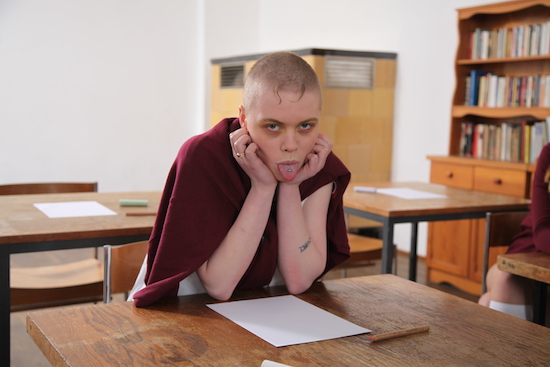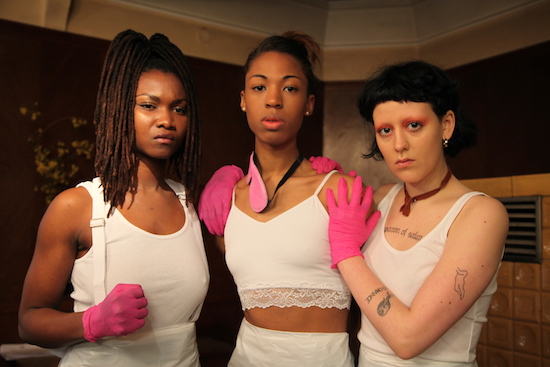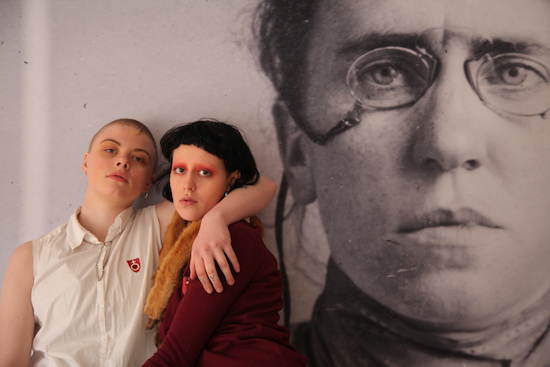Bruce LaBruce is the migraine of the masses. For more than thirty years the Canadian writer-director-artist-dramatist-pornographer has broken and blurred so many lines that to label his work “controversial”, “subversive” or even “shocking” at this point would be a gross oversimplification.
Better to take the first step and focus on LaBruce’s complex and intricate procedures for rendering the (often taboo) subjects that he wants you to deal/fuck with: within two minutes (or less) he will invade the most vulnerable corners of your subconscious, and then – when everything is imprinted on remote memories and the warnings turn off – he will offer himself as your trustworthy guide in exploring a carefully calculated universe. Or at least that’s what John Waters declared in a candid interview for the 2011 documentary Advocate for Fagdom, when asked about his perspective on the body of work created by the self-declared ‘Reluctant Pornographer’.
In effect, LaBruce has been refining a provocative cinematic experience in which explicit sex-scenes, male prostitution, hardcore sex practices, live performance, bold humour, crude encounters, in-your-face agitprop imagery, and pointed self reference collide. This gamut of cinematic variations demonstrates that multiple arousing systems, successfully bended and corrupted, can be re-introduced to once-hidden filmic references, confronting audiences with polymorphous subjects covering gay orthodoxy, sexual diasporas and the voracious ratiocination of capitalism, without anyone even noticing it.
Bruce LaBruce is an effortless theory-mixtape-maker, a master of pornsonification, who reunites society’s rejected, melting together radical politics, queer underground culture, technocracy and street knowledge, un-life and immortality, only to secrete it within the cracks of a corpulent industry
I wanted to speak to LaBruce about the legacy of his 2004 film The Raspberry Reich, about the legal turmoil that resulted from the heirs of photographer Alberto Korda objecting to the use of his famous photo of Che Guevara, the ‘Guerrillero Heroico’, about the different versions of the film proliferating across porn and non-porn channels, its role as Trojan Horse amidst the explosion of the -tube world, recruiting members to a homosexual intifada, newly aware of the Red Army Faction. What resulted was an extended conversation on agitprop, insurrectionary porn, and the bedroom as a site of disruption.

Portrait of Bruce LaBruce by Saad Al Hakkak. All other images courtesy Bruce LaBruce
Bruce LaBruce is the migraine of the masses. There’s no doubt about it.
I’m curious about the eclectic reactions people have had since you released The Raspberry Reich in 2004. How do you feel today about the influence that film has had on your career, fourteen years later
The Raspberry Reich experience was a wild ride for me. I was struggling to get films made in that era. At several points in my filmmaking “career” (I still hate the word), I tried and failed to get bigger-budgeted films off the ground. Although we regarded them as sexually explicit art films, my long-time producer, Juergen Bruning, and I gained reputations as pornographers for my first three films, No Skin Off My Ass (1991), Super 8 ½ (1994), and Hustler White (1996), which made it difficult for me to secure financing for bigger films.
Juergen dealt with it in his inimitable fashion by starting the very first porn company in Berlin, Cazzo Film, and I began directing actual porn movies for him with the stipulation that I could release both hardcore and softcore versions, the latter more suitable for film festival play and theatrical release.
My neo-Nazi porn film Skin Flick (1999) (hardcore title: Skin Gang) was the first movie I did following this model, and The Raspberry Reich (2004) (hardcore title: The Revolution Is My Boyfriend) was the second. Happily, these “side projects” ended up being just as interesting –if not more so – than the bigger films I didn’t manage to get made, largely because they were low-budget and pornographic so I was given complete creative freedom as long as I provided the requisite porn scenes.
I call these two films my first “legitimate” works of porn because for the first time I was actually working with professional porn actors and working within the conventions of porn, although I challenged them as far as I could.
It’s a long story, but nine months before 9/11, I fell in love with a closeted devout Shia Muslim who became my boyfriend, more or less, for three years (he appears at the beginning of The Raspberry Reich in the midst of religious ecstasy). It was strange because before that time I knew very little about Islam, but he certainly gave me a crash course!
I was writing in defence of Islam both before and after 9/11 for a couple of columns I was writing at the time for Toronto publications. So terrorism was the order of the day, so to speak, and that’s when a big shift to the right and neo-conservatism took hold with the rise of patriotism, jingoism, and war-mongering. I was alarmed by how a lot of leftist discourse was squelched in the public domain after 9/11, but I was equally alarmed by how ineffectual the left was – and still is – at combatting the shift to the right. The left was becoming increasingly entrenched in dogma and doctrinaire politics, relying on shibboleths and paying lip service to radicalism.
Tony Blair’s Labour Party in England, a formerly socialist entity, gutted unions and formed an alliance with the Bush Republicans advocating conquest and a return to colonialism. Meanwhile, the far left was reduced to a kind of fashionable nostalgia. “Radical chic” became popular – witness the capitalist exploitation of Alberto Korda’s famous image of Che Guevera, emptied of all political significance and reduced to a kind of logo of vague radicalism.
So this was the zeitgeist that inspired The Raspberry Reich, which, incidentally, came out the same day as The Motorcycle Diaries, a radical chic movie about Che that finally presents him as a Hollywood matinee idol. Smart critics noted the irony of the two films coming out at the same time, and I actually did get a lot of good reviews for the film. It played at over a hundred film festivals and was on its way to becoming a cult hit when, about six months into my tour with the film, Jurgen and I got hit with a million dollar (Canadian) lawsuit for copyright infringement by the Korda estate.
The lawsuit was launched in France, which has some of the toughest copyright laws in the world, but the sixty-page court document was delivered to my door in Toronto by a local sheriff, so it was pretty heavy. We got a famous gay French lawyer, Emmanuel Pierrat, to defend us, but we technically lost. The damages were reduced to about €8,000, but we had to cover the court costs, so we ended up having to pay about €30,000 (the budget of the film was about 60,000!), effectively erasing all our profits from the film.
The film is a critique of radical chic and both a critique and celebration of the radical left, but it is obviously anti-capitalist, so the irony of being scuttled by Che and Korda over copyright was bitter.
They argued mostly that we “demeaned” and “defiled” the image of Che, although I didn’t really intend having a hot porn star jerk off on a blow-up of the Che image to be demeaning at all – more of an homage, really. I just figured everyone else in the world was jerking off to the image, so I might as well show it literally.
The film’s slogans, particularly “The Revolution is My Boyfriend,” started to be widely quoted online and on t-shirts and banners, neatly mirroring the radical chic critiqued in the movie. Meanwhile, after I got back from a tour with the movie in 2005, I met my future husband, a Cuban dancer at the famous Tropicana in Havana who defected to Canada during the ‘Special Period’ in the 90s when he was in his early thirties. He used to tease me because I made this film about revolution and revolutionaries while he actually lived through a REAL revolution with all the complexities and paradoxes and hardships it entailed. He affectionately called me “Brucito Subversivo”.
My fascination with the Red Army Faction, which started when I read Jillian Becker’s book Hitler’s Children, published in 1977, when I was a punk in the mid eighties, continued, and I’ve revisited the theme of terrorist chic, abduction, fuckwashing, and revolution, a number of times since.
In Los Angeles, at the gallery that represents me, Peres Projects, I mounted a show in 2007 called Heterosexuality Is the Opiate of the Masses at whose opening I performed a live porn-lite abduction scenario/Polaroid performance piece involving terrorists, guns, slogans, faux-violence, and a lot of fake blood. Over the next ten years I did variations of this performance at other galleries in Barcelona, Toronto, New York, London, and Pittsburgh, at the Warhol Museum.
I directed a short in 2010 called Give Piece of Ass a Chance, which is a dyke homage to The Raspberry Reich written by a burlesque performer and sex trade worker-activist, which features explicit lesbian sex. And most recently, my films The Misandrists and Ulrike’s Brain explore the same territory in lesbian feminist terms.
Oh, and I made a short porn film called The Purple Army Faction starring François Sagat, which also involves terrorist abduction and fuckwashing in a gay context. So the legacy continues!

I’m interested in the use of agit-prop strategies in the film. How did you arrive at this juxtaposition of sex scenes, provocative dialogue and flashed up intertitles?
If you follow the maxim “Talent borrows, genius steals,” then The Raspberry Reich is genius. I stole quite brazenly from a number of sources, including Raoul Vaneigem’s The Revolution of Everyday Life, Dušan Makaveyev’s WR: Mysteries of the Organism, Jean-Luc Godard’s La Chinoise, Fassbinder’s The Third Generation, and other works that I’ve probably forgotten.
But this is a style that I’d been developing since my involvement with the Queercore movement, including my fanzines and early super 8 experimental films. It’s a kind of collage technique – or bricolage, détournement, whatever you want to call it. In my early Super-8 films I would combine material that I shot directly off the television, found footage, and scenes that I shot myself, and repurpose it – or “queer” it – for my own political purposes. It’s a synthesis of unlikely source material – found pornography, classic Hollywood film imagery and music, punk imagery and music, etc. – that creates unexpected and complex meanings and signification.
The point is to make this act of “stealing” into a work that expresses your own style and meaning. Godard often used agit-prop text in his 60s movies, but I use the same technique in conjunction with gay pornography and queer activism, which gives it a whole new purpose and significance.
I am also critiquing his critique of radical chic, so there are many layers. I subvert already “revolutionary” slogans like “Religion is the Opiate of the Masses,” for my own radical queer purposes, ending up with “Heterosexuality is the Opiate of the Masses.”
One of the recognisable traits of my work is that if the audience thinks I’m being sarcastic, I’m probably being sincere, and if they think I’m being sincere, I’m probably being sarcastic. Ambivalence and ambiguity are both strategies I picked up from the punk movement. It makes you more nimble, hard to pin down, difficult to co-opt.
Another trait of my work is that I often critique a film or a movement or a tendency at the same time that I celebrate it or appreciate it. I acknowledge my own ambivalence toward my subjects.
As for the agit-prop technique of The Raspberry Reich, I have always maintained that pornography is the perfect vehicle for propaganda. The audience is put into a receptive, sexually aroused state, so it’s like a spoonful of sugar that helps the political message go down! Porn is like a collective sexual subconscious, so the political message or “propaganda” enters the subconscious realm.
A characteristic of my work which has developed from years of making no-budget film with limited access to proper equipment or crew is turning the mistakes – or disasters!– in my filmmaking into its greatest strengths. So for The Raspberry Reich, I had a sound recordist who was completely inexperienced, so the recorded sound was unusable, and I had very limited resources to make the film, so the footage didn’t look very good. Out of necessity, I went into a studio and post-dubbed the entire movie, which gives it the feeling of a propaganda film, or a B-movie, or a foreign film you would see on television.
The whole over-determined agit-prop style with so many slogans and so much text crossing the screen most of the time, in one sense, was a way to disguise how lacklustre the footage looked! I hated the footage during editing, but when we spruced it up with all the colours and text and overlays, it became quite stylish! I didn’t really know if the post-dubbing would work, so the editing process was a bit torturous, not knowing if the film could be salvaged. But this is how I often work, making your limitations work for you.

I’d like to talk about the way in which you use bedrooms as unusual spaces for intimate sexual and political disruption. In many of the set-ups, the bed is a place where (usually queer bodies) are used as thresholds for insights into particular mindsets and ideological postures. There’s moments I’m remembering right now from Otto or Up with Dead People, Hustler White, Gerontophilia or Skin Flick… these moments in which sex goes beyond a simple physical performance.
In The Raspberry Reich, Gudrun says “sexuality is a force of nature that cannot be contained by a mattress or a sheet,” and she chants, “Out of the Bedrooms, Onto the Streets!” as she and Holger fuck their way out of the bedroom and into the living room and then out of their apartment and into a public elevator…
But yes, beds are often a nexus of sexual provocation and disruption in my movies. Starting with my first feature, No Skin Off My Ass, the hairdresser and his love object, the neo-Nazi skinhead, end up in bed together, a scene that is both romantic and pornographic, both ironically and unironically. In mainstream cinema the bed is often the site of heterosexual monogamy and normalcy, with countless Hollywood movies showing the husband and wife in bed talking or having mostly boring sex, and the sex scene itself is often elided. But I try to subvert this reactionary tendency by making it a site of fetish and perversion.
Can you share your experience of filming in the streets of Berlin for Refugees Welcome, your short film that was rejected by the Berlinale? I’m particularly interested in the sex scene towards the end of the film, with the highway in the background.
The idea for Refugee’s Welcome actually came from meeting Pig Boy, the Czech pornstar, online. When we chatted I discovered that he is also a published poet and quite a smart man, definitely debunking the stereotypical pornstar image.
At the time I was looking for a project to do with Erika Lust’s porn company, so I came up with the refugee concept, having become aware of the situation in Berlin and seeing the “Refugees Welcome” signs in the windows of certain cafes and bars. So I cast Pig Boy as the poet who saves the refugee from the racist neo-Nazi skinheads. But then I had to cast the refugee.
I put a casting notice on social media, looking for a Syrian, but this proved to be impossible, so I ended up casting Jesse Charif, who is Lebanese. He had never done a porno before, so it was a bit of a risk. But he and Pig Boy ended up having great sexual chemistry, and they were both very sweet to work with.
We shot the opening scene of Jesse at the exterior of an actual refugee centre in Berlin. We shot the scene where they meet, while Pig Boy is giving a poetry reading, at an actual anarchist cafe that already had a “Refugees Welcome” sign in the window!
I heard later that the producers arranged a screening of the film at the same cafe, and they didn’t like the movie at all! They complained about the “white saviour” angle and didn’t like that the white character topped the refugee! The latter is ridiculous, since, a, I don’t consider bottoming any sort of humiliation or degradation – unless you want it to be! – and, b, I asked Jesse to also fuck Pig Boy up the ass, but he wasn’t comfortable with it so we didn’t do it.
The final scene by the highway was improvised. I was across the busy street at the exit to the freeway yelling, “fuck him, fuck him,” so Pig Boy pulled down Jesse’s pants and started fucking him. I was too far away to tell if they were actually doing it at that point.
The Erika Lust people were amazing because not only was it the first totally gay film they produced, but also they gave me a total free hand, allowing me to include political and religious content, which they generally steer away from. The film also references a number of my other films about skinheads, especially Skin Flick.

I am reminded of the reception that your film The Misandrists got from festivals like Frameline, who allegedly rejected it for screening because it’s a film about lesbians directed by a gay man. I find similarities, too, with John Waters’ Desperate Living (1977), which was picketed by lesbian groups in Boston, saying “how dare a man make a comedy about lesbians!” Do you think we are witnessing a new wave of gay conservatism?
I have always questioned identity politics with my work. I often have characters that engage in homosexual sex but do not identify as gay (hustlers, neo-Nazi skinheads, extreme left wing revolutionaries, gerontophiles, etc.). But my films have also always been inclusive in terms of race, class, and gender. I find that the new emphasis on identity politics has really narrowed creative expression. It demonstrates a profound ignorance about sexuality, history, and human experience.
My sexual identity is pretty much fixed – I’m a Kinsey 6, if not a 7 – but I acknowledge that this means I’m sexually repressed. I believe, after Freud, that everyone has some bisexual potential, and the tendency to increasingly entrench gender identity as innate and immutable is really preposterous. It also leads to strict rules about sexual representation – how gays, lesbians and transgender people “must” be portrayed, the policing of representation, a kind of proprietary stance about who is allowed to portray these characters.
It really boils down to a naivety about sexuality, and a complete failure of the imagination. It discourages people who may have the potential for some kind of sexual fluidity to express themselves.
I’ve always been a “bad gay,” but now this political correctness has made me feel even more alienated from the notion of “gay identity” – particularly since the new assimilationist model is so conservative and dull.
Having The Misandrists rejected by a number of major LGBTQ festivals actually was the best thing that could have happened to the film. In the USA, for example, the film ended up being released in thirty cities, in theatres and venues that encouraged a broader audience to view it. I found it encouraging that a film that takes on issues of gender, feminism, and identity politics in a challenging way found its audience in the current climate. The discussions around the film, whether negative or positive, were refreshing.
Not every representation of an LGBTQ character should be expected to adhere to “positive reinforcement.” Some of my favourite gay characters in cinema have been evil or criminal or camp or tragic. Having said that, I still support the idea of LGBTQ characters being represented as militant and extreme – even separatist. I try to contradict myself at least once a day. Clichés can sometimes be liberating.
Purple Army Faction is a short (porn) film made in collaboration with Jake Jaxson, CEO of gay adult entertainment company, CockyBoys. What inspired the strange new world scenario of this film – with its astonishing use of propaganda slogans – rather than just revisiting previous works for CockyBoys?
Purple Army Faction is made in a similar style to my films The Raspberry Reich and Give Piece of Ass a Chance. It’s agitprop, satire, pastiche, and porn all in one. This is what I mean by embracing gay extremist scenarios and characters and not being afraid to depict clichés, which are often based in a certain amount of truth.
When I was in University, there was an anti-gay group called the League Against Homosexuals who would have meetings and post fliers on campus. Their motto was “Queers Don’t Produce, They Seduce.” So this was the starting point for The Purple Army Faction, basically embracing this slogan and extrapolating its sentiment into a speculative future where, because of over-population, it might be necessary to discourage breeding by converting mass numbers of straight men to homosexuality! (That is, converting them to the model of the “old school” gay, for whom having children wasn’t particularly desirable.) It’s a neat corrective to the idea of trying to convert gays to heterosexuality, in this case justifying the reversal of that repulsive activity through a moral and biological imperative.
In this case, as in The Misandrists in lesbian terms, I am absolutely supporting the idea of a fixed sexual identity, but only when it is in the service of militancy, political radicalism, and glamour! The gay guys that convert the straight character in The Purple Army Faction are so sexy and stylish that anyone would want to be converted to gayness by them!
The film is also obviously a reaction against gay conservatism and assimilation, which essentially expects gays to become homonormative simulacrums of heteronormativity. And of course, along with the other two similar films of mine I mentioned, it was important that the film be strongly pornographic in order to convey convincingly and authentically the concept of sexual revolution and gay radicalism.

Ulrike’s Brain is your first project conceived as a B-movie. How did this idea come about? Can we expect more B-movies of your films in the future?
The idea behind Ulrike’s Brain is not so far from science fiction. After Ulrike Meinhof, Andreas Baader, Gudrun Ensslin, and Jean-Carl Raspe, the four main members of the Red Army Faction, were suspiciously found dead in Stammheim prison, their brains were removed by the authorities to be examined by neuropathologist Dr Jürgen Peiffer of Tübingen University. Peiffer’s examination of Ulrike Meinhof’s brain led him to the dubious conclusion that an operation to remove a benign tumour in 1962 caused damage significant enough to have contributed directly to her subsequent terrorist behaviour. Supporters of the RAF, who refused to believe that the actions of the left wing revolutionary were the result of a sick mind, vigorously opposed this theory.
The examinations of the brains of the dead revolutionaries, who some believed were murdered by the state, also conjured visions of the grotesque medical experiments conducted during the Third Reich. The subsequent revelation that the four terrorist brains had mysteriously disappeared and were unaccounted for added a further level of science fiction to the entire spectacle. Only Ulrike’s Brain was finally located and returned to her daughters to be interred with her body in 2002.
Referencing sixties B-movies like They Saved Hitler’s Brain and The Brain That Would Not Die, Ulrike’s Brain finds Doctor Julia Feifer (Susanne Sachsse) arriving at a scientific conference with an organ box containing the brain of the real Ulrike Meinhof, which was saved by the authorities along with the other three brains of the leaders of the RAF after they all died in Stammheim prison.
It soon becomes apparent that Doctor Feifer can communicate telepathically with Ulrike’s brain, which is directing her to lead a new feminist revolution. To that end, Doctor Feifer is searching for the ideal female body to transplant Ulrike’s Brain into.
At the same time, her arch-rival, Detlev Schlesinger, an extreme right wing ideologue, arrives at the conference with the ashes of Michael Kuhnen, the former German neo-Nazi leader and infamous homosexual who died of AIDS in 1989. Through mystical practice and occult ritual, Schlesinger intends to raise the spirit of Kuhnen from the dead, reincarnating him in a body he has robbed from a grave as a kind of zombie, to challenge Feifer’s left wing insurgency.
When the two Frankenstein’s monsters of the extreme left and the extreme right meet, chaos ensues.
Ulrike’s Brain, the movie, all began as a performance-installation at the conference Die Untoten: Life Sciences and Pulp Fiction, an event curated in 2011 by Hannah Hurtzig at Kampnagel in Hamburg, the largest independent production venue for the performing arts in Germany. Hurtzig commissioned me to create a performance event to run parallel to the conference, which concerned researches and speculations about the zones of indeterminacy: the intersection of life and death.
I decided to make a film for the event referencing pulp science-fiction movies of the 60s, foregrounding the making of the film, which was performed in front of live audiences during the conference. Susanne Sachsse, who plays Dr. Feifer, gave an actual lecture at the conference, posing as a “real” academic, adding an extra layer of obfuscation to the proceedings. Shooting extra material on location in Hamburg, I turned the performance-installation into an experimental film.
I don’t really have any immediate plans to make another B-movie per se, although I have a few script ideas that contain B-movie elements.
In an interview for the premiere of Ulrike’s Brain and The Misandrists at last year’s Berlinale you declared that cinema should be insurrectionary. What would be the golden rules for making fearless insurrectionary cinema according to Bruce LaBruce?
1) Question authority.
2) Support your local pornographer; all porn is art.
3) Don’t be ashamed to use shock value and sheer provocation as ends in themselves.
4) Challenge conventions, both formal, cinematic ones and cultural, heteronormative ones.
5) Support your local prostitute, because you are probably one too.
6) Kill your cinematic idols.
7) Make porn, not war.
8) Challenge the gay orthodoxy.
9) Shock yourself. If you think you’ve gone too far, it’s probably a good sign, artistically speaking.
10) Never succumb to political correctness or conventional wisdom!


